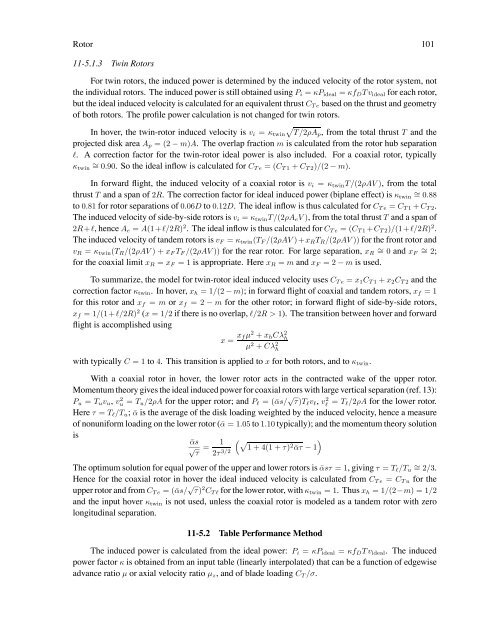Download - NASA
Download - NASA
Download - NASA
Create successful ePaper yourself
Turn your PDF publications into a flip-book with our unique Google optimized e-Paper software.
Rotor 101<br />
11-5.1.3 Twin Rotors<br />
For twin rotors, the induced power is determined by the induced velocity of the rotor system, not<br />
the individual rotors. The induced power is still obtained using Pi = κPideal = κfDTvideal for each rotor,<br />
but the ideal induced velocity is calculated for an equivalent thrust CTe based on the thrust and geometry<br />
of both rotors. The profile power calculation is not changed for twin rotors.<br />
<br />
In hover, the twin-rotor induced velocity is vi = κtwin T/2ρAp, from the total thrust T and the<br />
projected disk area Ap =(2−m)A. The overlap fraction m is calculated from the rotor hub separation<br />
ℓ. A correction factor for the twin-rotor ideal power is also included. For a coaxial rotor, typically<br />
κtwin ∼ = 0.90. So the ideal inflow is calculated for CTe =(CT1 + CT 2)/(2 − m).<br />
In forward flight, the induced velocity of a coaxial rotor is vi = κtwinT/(2ρAV ), from the total<br />
thrust T and a span of 2R. The correction factor for ideal induced power (biplane effect) is κtwin ∼ = 0.88<br />
to 0.81 for rotor separations of 0.06D to 0.12D. The ideal inflow is thus calculated for CTe = CT 1 + CT 2.<br />
The induced velocity of side-by-side rotors is vi = κtwinT/(2ρAeV ), from the total thrust T and a span of<br />
2R+ℓ, hence Ae = A(1+ℓ/2R) 2 . The ideal inflow is thus calculated for CTe =(CT 1 +CT 2)/(1+ℓ/2R) 2 .<br />
The induced velocity of tandem rotors is vF = κtwin(TF /(2ρAV )+xRTR/(2ρAV )) for the front rotor and<br />
vR = κtwin(TR/(2ρAV )+xF TF /(2ρAV )) for the rear rotor. For large separation, xR ∼ = 0 and xF ∼ = 2;<br />
for the coaxial limit xR = xF =1is appropriate. Here xR = m and xF =2− m is used.<br />
To summarize, the model for twin-rotor ideal induced velocity uses CTe = x1CT 1 + x2CT 2 and the<br />
correction factor κtwin. In hover, xh =1/(2 − m); in forward flight of coaxial and tandem rotors, xf =1<br />
for this rotor and xf = m or xf =2− m for the other rotor; in forward flight of side-by-side rotors,<br />
xf =1/(1 + ℓ/2R) 2 (x =1/2 if there is no overlap, ℓ/2R >1). The transition between hover and forward<br />
flight is accomplished using<br />
x = xf μ 2 + xhCλ 2 h<br />
μ 2 + Cλ 2 h<br />
with typically C =1to 4. This transition is applied to x for both rotors, and to κtwin.<br />
With a coaxial rotor in hover, the lower rotor acts in the contracted wake of the upper rotor.<br />
Momentum theory gives the ideal induced power for coaxial rotors with large vertical separation (ref. 13):<br />
Pu = Tuvu, v 2 u = Tu/2ρA for the upper rotor; and Pℓ =(¯αs/ √ τ)Tℓvℓ, v 2 ℓ = Tℓ/2ρA for the lower rotor.<br />
Here τ = Tℓ/Tu; ¯α is the average of the disk loading weighted by the induced velocity, hence a measure<br />
of nonuniform loading on the lower rotor (¯α =1.05 to 1.10 typically); and the momentum theory solution<br />
is<br />
¯αs<br />
√ τ = 1<br />
2τ 3/2<br />
<br />
1 + 4(1 + τ) 2 ¯ατ − 1<br />
The optimum solution for equal power of the upper and lower rotors is ¯αsτ =1, giving τ = Tℓ/Tu ∼ = 2/3.<br />
Hence for the coaxial rotor in hover the ideal induced velocity is calculated from CTe = CTu for the<br />
upper rotor and from CTe =(¯αs/ √ τ) 2 CTℓ for the lower rotor, with κtwin =1. Thus xh =1/(2−m) =1/2<br />
and the input hover κtwin is not used, unless the coaxial rotor is modeled as a tandem rotor with zero<br />
longitudinal separation.<br />
11-5.2 Table Performance Method<br />
The induced power is calculated from the ideal power: Pi = κPideal = κfDTvideal. The induced<br />
power factor κ is obtained from an input table (linearly interpolated) that can be a function of edgewise<br />
advance ratio μ or axial velocity ratio μz, and of blade loading CT /σ.
















